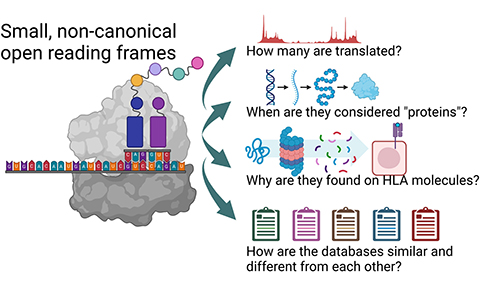Improvements in human genome databases offer a promising future for cancer research
A gene sequencing method called ribosome profiling has expanded our understanding of the human genome by identifying previously unknown protein coding regions. Also known as Ribo-seq, this method allows researchers to get a high-resolution snapshot of protein production in cells.
Ribo-seq has the potential to advance cancer research, but many of the discoveries enabled by Ribo-seq provide an untraditional view of where and how protein production might happen. As such, scientists must first verify these regions code for proteins.
A tool for cancer research

“Ribo-seq has garnered major interest for use in studying protein production in cancer cells to identify a specific abnormal proteins as targets for immunotherapy or other treatment approaches,” said John Prensner, a physician-researcher and assistant professor in the University of Michigan Medical School Departments of Pediatrics and Biological Chemistry.
Immunotherapy treatment activates the patient’s own immune system to destroy cancer cells. It lacks the toxic side effects of chemotherapy like nausea, vomiting and hair loss, making it a highly desirable treatment for patients that qualify.
Currently, immunotherapy is only available for certain cancers. Tumors that produce a large number of proteins with easily identifiable mutations are compatible with immunotherapy. Drugs have been developed to target those proteins to unleash the immune system against cancerous cells.
Scientists hope to use Ribo-seq as a tool to understand the proteins cancer cells produce to expand immunotherapy’s success to a larger number of cancer patients.
Investigating protein machines
Producing a protein requires two steps — transcription and translation. Ribo-seq zeroes in on the second step of translation.
During transcription, the cell takes the DNA master blueprint and makes a copy of the genetic instructions known as messenger RNA or mRNA. The messenger RNA is then shuttled over to a ribosome, a tiny protein factory within the cell, to start the process of translation. The ribosome translates the instructions to link amino acids together to form a protein.
In the past, researchers have used RNA sequencing or RNA-seq to identify genes that are activated to make proteins in a given tissue sample, Prensner said. For example, RNA-seq could be used to identify which genes a cancer cell is using to make proteins and identify any mutations in those proteins.
RNA-seq is a proxy for the process of translation, but there are multiple factors that can alter results. Ribo-seq analyzes the translation process, giving a clearer picture of the rate and location of translation.
Collaboration to improve databases
When scientists first get back the results of any genetic sequencing, to make any sense of the long list of letters, they must align the genetic sequence to a reference genome. Reference genomes are a digital database of an accepted representation of an organism’s gene sequence.
If a scientist is studying cancer biology in the human genome, they would use a human genome reference sequence as a standard comparison to the gene sequence generated in their study to learn more about function. Currently, human genome reference databases are not well equipped to recognize Ribo-seq results. The lack of standardization inhibits Ribo-seq’s use for the global research community.
To remedy this, Prensner, whose lab focuses on the molecular basis of pediatric brain cancers, teamed up with an international group of researchers to begin a project to improve human genome reference databases for Ribo-Seq use.
During Phase I of the project, this team of research organizations produced a standardized catalog of 7,264 Ribo-seq open reading frames — spans of DNA fragments that code for proteins — which is made freely available to scientists worldwide. Although a good start, this catalog requires additional scrutiny to answer a critical question for the research community: How many of these open reading frames truly produce a protein product?
Cross-checking results
Prensner led a research effort to integrate Ribo-Seq and proteomics techniques, laboratory methods to confirm the presence of a protein within a cell, to increase researchers’ confidence in whether these Ribo-Seq open reading frames produce proteins. The results are published in Molecular & Cellular Proteomics. The research team proposes a framework to standardize levels of evidence for these newly identified protein-coding regions.
Classifications vary from “protein candidate” with the strongest required supporting evidence to “detected” with the least required supporting evidence.
“We believe this common terminology and shared database resources will reduce confusion and improve the precision of research on these open reading frames identified by Ribo-Seq,” Prensner said.
Improved databases will support more accurate gene sequencing interpretations and foster insights in cancer as well as across all aspects of human biology for years to come.
This article was first published by Health Lab, Michigan Medicine’s daily online publication. Read the original.
Enjoy reading ASBMB Today?
Become a member to receive the print edition four times a year and the digital edition monthly.
Learn moreGet the latest from ASBMB Today
Enter your email address, and we’ll send you a weekly email with recent articles, interviews and more.
Latest in Science
Science highlights or most popular articles

Building the blueprint to block HIV
Wesley Sundquist will present his work on the HIV capsid and revolutionary drug, Lenacapavir, at the ASBMB Annual Meeting, March 7–10, in Maryland.

Gut microbes hijack cancer pathway in high-fat diets
Researchers at the Feinstein Institutes for Medical Research found that a high-fat diet increases ammonia-producing bacteria in the gut microbiome of mice, which in turn disrupts TGF-β signaling and promotes colorectal cancer.

Mapping fentanyl’s cellular footprint
Using a new imaging method, researchers at State University of New York at Buffalo traced fentanyl’s effects inside brain immune cells, revealing how the drug alters lipid droplets, pointing to new paths for addiction diagnostics.

Designing life’s building blocks with AI
Tanja Kortemme, a professor at the University of California, San Francisco, will discuss her research using computational biology to engineer proteins at the 2026 ASBMB Annual Meeting.

Cholesterol as a novel biomarker for Fragile X syndrome
Researchers in Quebec identified lower levels of a brain cholesterol metabolite, 24-hydroxycholesterol, in patients with fragile X syndrome, a finding that could provide a simple blood-based biomarker for understanding and managing the condition.

How lipid metabolism shapes sperm development
Researchers at Hokkaido University identify the enzyme behind a key lipid in sperm development. The findings reveal how seminolipids shape sperm formation and may inform future diagnostics and treatments for male infertility.


